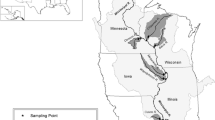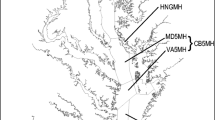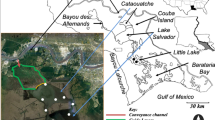Abstract
Management efforts to control excess algal growth in the Neuse River and Estuary, North Carolina began in the 1980s, with an initial focus on phosphorus (P) input reduction. However, continued water quality problems in the 1990s led to development of a Total Maximum Daily Load (TMDL) for nitrogen (N) in 1999 to improve conditions in N-sensitive estuarine waters. Evaluation of the effectiveness of management actions implemented in the Neuse River basin is a challenging endeavor due to natural variations in N export associated with climate. A simplified approach is presented that allows evaluation of trends in flow-normalized nutrient loading to provide feedback on effectiveness of implemented actions to reduce N loading to estuarine waters. The approach is applied to five watershed locations, including the headwaters of the Neuse Estuary. Decreases in nitrate + nitrite (NO3–N) concentrations occurred throughout the basin and were largest just downstream of the Raleigh metropolitan area. Conversely, concentrations of total Kjeldahl N (TKN) increased at many stations, particularly under high flow conditions. This indicates a relative increase in organic N (Org-N) inputs since the mid-1990s. Overall, patterns in different N fractions at watershed stations indicate both partial success in reducing N inputs and ongoing challenges for N loading under high flow conditions. In downstream waters, NO3–N concentrations decreased concurrent with TMDL implementation in the upper portion of the estuary but not in the middle and lower reaches. The lack of progress in the middle and lower reaches of the estuary may, at least in part, be affected by remineralization of settled particle-bound N deposited under high river flows.









Similar content being viewed by others
References
Alexander RB, Smith RA, Schwarz GE (2000) Effect of stream channel size on the delivery of nitrogen to the Gulf of Mexico. Nature (London) 403:758–761
Alexander RB, Smith RA, Schwarz GE, Boyer EW, Nolan JV, Brakebill JW (2008) Differences in phosphorus and nitrogen delivery to the Gulf of Mexico from the Mississippi River Basin. Environmental Science and Technology 42:822–830
Bales JD (2003) Effects of Hurricane Floyd inland flooding, September–October 1999, on tributaries to Pamlico Sound, North Carolina. Estuaries 26:1319–1328
Boesch DF, Burreson E, Dennison W, Houde E, Kemp M, Kennedy V, Newell R, Paynter K, Orth R, Ulanowicz W (2001) Factors in the decline of coastal ecosystems. Science 293:629–638
Boyer JN, Christian RR, Stanley DW (1993) Patterns of phytoplankton primary productivity in the Neuse River Estuary, North Carolina, USA. Marine Ecology Progress Series 97:287–297
Bradley PB, Lomas MW, Bronk DA (2010a) Inorganic and organic nitrogen use by phytoplankton along Chesapeake Bay, measured using a flow cytometric sorting approach. Estuaries and Coasts 33:971–984
Bradley P, Sanderson MP, Frischer ME, Brofft J, Booth MG, Kerkhof LJ, Bronk DA (2010b) Inorganic and organic nitrogen uptake by phytoplankton and heterotrophic bacteria in the stratified Mid-Atlantic Bight. Estuarine Coastal Shelf Science 88:429–441
Bricker S, Longstaff B, Dennison W, Jones A, Boicourt K, Wicks C, Woerner J (2007) Effects of nutrient enrichment in the nation’s estuaries: a decade of change. NOAA Coastal Ocean Program Decision Analysis Series No. 26. National Centers for Coastal Ocean Science, Silver Spring, p 328
Burkholder JM, Dickey DA, Kinder CA, Reed RE, Mallin MA, McIver MR, Cahoon LB, Melia G, Brownie C, Smith J, Dreamer N, Springer J, Glasgow HB, Toms D (2006) Comprehensive trend analysis of nutrients and related variables in a large eutrophic estuary: a decadal study of anthropogenic and climatic influences. Limnology and Oceanography 51:463–487
Christian RR, Boyer JN, Stanley DW (1991) Multi-year distribution patterns of nutrients within the Neuse River Estuary. Marine Ecology and Progress Series 71:259–274
Christian RR, O’Neal B, Peierls BL, Valdes L, Paerl HW (2004) Episodic nutrient loading impacts on eutrophication of the southern Pamlico Sound: the effects of the 1999 hurricanes. Water Resources Research Institute Report No. 349. University of North Carolina Water Resources Research Institute, Raleigh
Cloern JE (2001) Our evolving conceptual model of the coastal eutrophication problem. Marine Ecology and Progress Series 210:223–253
Conley DJ, Paerl HW, Howarth RW, Boesch DR, Seitzinger SP, Havens KE, Lancelot C, Likens GE (2009) Controlling eutrophication: nitrogen and phosphorus. Science 323:1014–1015
Diaz RJ, Rosenberg R (2008) Spreading dead zones and consequences for marine ecosystems. Science 321:926–929
Fisher TR, Carlson PR, Barber RT (1982) Sediment nutrient regeneration in three North Carolina Estuaries. Estuarine Coastal Shelf Science 14:101–116
Fisher TR, Hagy JD, Boynton WR, Williams MR (2006) Cultural eutrophication in the Choptank and Patuxent estuaries of Chesapeake Bay. Limnology and Oceanography 51:535–547
Giese GL, Wilder HB, Parker GG (1985) Hydrology of major estuaries and sounds of North Carolina. Water Supply Paper 2221. United States Geological Survey, Alexandria
Giffin D, Corbett DR (2003) Evaluation of sediment dynamics in coastal systems via short-lived radioisotopes. Journal of Marine Systems 42:83–96
Harned DA, Davenport MS (1990) Water-quality trends and basin activities and characteristics for the Albemarle-Pamlico estuarine system. North Carolina and Virginia. Report No. 90-398. United States Geological Survey, Raleigh
Harrington MB (1999) Responses of natural phytoplankton communities from the Neuse River Estuary, NC to changes in nitrogen supply and incident irradiance. MSc Thesis, University of North Carolina, Chapel Hill, North Carolina
Hirsch RM, Moyer DL, Archfield SA (2010) Weighted regressions on time, discharge, and season (WRTDS), with an application to Chesapeake Bay river inputs. Journal of American Water Resources Association 46:857–880
Hobbie JE, Smith NW (1975) Nutrients in the Neuse River Estuary, North Carolina. Report No. UNC-SG-75-21, UNC Sea Grant Program, NC State University
Lebo ME, McHenry DG, Fromm JH (2002) Neuse River Estuary modeling and monitoring project stage 1: evaluating historical nutrient and chlorophyll patterns in the Neuse River Basin. University of North Carolina Water Resources Research Report No. 325-H, Raleigh
Mallin MA, Paerl HW, Rudek J (1991) Seasonal phytoplankton composition, productivity, and biomass in the Neuse River Estuary, North Carolina. Estuarine Coastal Shelf Science 32:609–623
Mallin MA, Paerl HW, Rudek J, Bates PW (1993) Regulation of estuarine primary production by watershed rainfall and river flow. Marine Ecology Progress Series 93:199–203
Meals DW, Dressing SA, Davenport TE (2010) Lag time in water quality response to best management practices: a review. Journal of Environmental Quality 39:85–96
National Research Council (2000) Clean coastal waters: understanding and reducing the effects of nutrient pollution. National Academy Press, Washington, DC
North Carolina Division of Water Quality (NCDWQ) (1998) Neuse River basin wide water quality plan. NC Department of Environmental and Natural Resources, Raleigh
NCDWQ (1999) Total maximum daily load for total nitrogen to the Neuse River Estuary, North Carolina, June 1999. NC Department of Environmental and Natural Resources, Raleigh
NCDWQ (2001) Phase II of the total maximum daily load for total nitrogen to the Neuse River Estuary, North Carolina, December 2001. NC Department of Environmental and Natural Resources, Raleigh
NCDWQ (2009) Neuse River basin wide water quality plan. NC Department of Environmental and Natural Resources, Raleigh
Nixon SW (1995) Coastal eutrophication: A definition, social causes, and future concerns. Ophelia 41:199–220
Paerl HW, Mallin MA, Donahue CA, Go M, Peierls BL (1995) Nitrogen loading sources and eutrophication of the Neuse River Estuary, NC: direct and indirect roles of atmospheric deposition. UNC Water Resources Research Institute Report No. 291, Raleigh
Paerl HW, Valdes LM, Piehler MF, Lebo ME (2004) Solving problems resulting from solutions: the evolution of a dual nutrient management strategy for the eutrophying Neuse River Estuary, North Carolina, USA. Environmental Science and Technology 38:3068–3073
Paerl HW, Valdes LM, Piehler MF, Stow CA (2006a) Assessing the effects of nutrient management in an estuary experiencing climatic change: the Neuse River Estuary, NC, USA. Environmental Management 37:422–436
Paerl HW, Valdes LM, Joyner AR, Peierls BL, Buzzelli CP, Piehler MF, Riggs SR, Christian RR, Ramus JS, Clesceri EJ, Eby LA, Crowder LW, Luettich RA (2006b) Ecological response to hurricane events in the Pamlico Sound System, NC and implications for assessment and management in a regime of increased frequency. Estuaries and Coasts 29:1033–1045
Paerl HW, Valdes LM, Adolf JE, Peierls BM, Harding LW Jr (2006c) Anthropogenic and climatic influences on the eutrophication of large estuarine ecosystems. Limnology and Oceanography 51:448–462
Paerl HW, Valdes LM, Joyner AR, Winkelmann V (2007) Phytoplankton indicators of ecological change in the nutrient and climatically-impacted Neuse River-Pamlico Sound System, North Carolina. Ecological Applications 17:88–101
Paerl HW, Christian RR, Bales JD, Peierls BL, Hall NS, Joyner AR, Riggs SR (2010) Assessing the response of the Pamlico Sound, North Carolina, USA to human and climatic disturbances: management implications. In: Kennish M, Paerl H (eds) Coastal lagoons: critical habitats of environmental change. CRC Marine Science Series, CRC Press, Boca Raton, pp 17–42
Peierls BL, Paerl HW (1997) The bioavailability of atmospheric organic nitrogen deposition to coastal phytoplankton. Limnology and Oceanography 42:1819–1823
Peierls BL, Christian RR, Paerl HW (2003) Water quality and phytoplankton as indicators of hurricane impacts on a large estuarine ecosystem. Estuaries 26:1329–1343
Pinckney JL, Paerl HW, Harrington MB (1999) Responses of the phytoplankton community growth rate to nutrient pulses in variable estuarine environments. Journal of Phycology 35:1455–1463
Qian SS, Borsuk ME, Stow CA (2000) Seasonal and long-term nutrient trend decomposition along a spatial gradient in the Neuse River watershed. Environmental Science and Technology 34:4474–4482
Rabalais NN, Turner RE, Diaz RJ, Justic D (2009) Global change and eutrophication of coastal waters. ICES Journal of Marine Science 66:1528–1537
Rothenberger MB, Burkholder JM, Brownie C (2009) Long-term effects of changing land use practices on surface water quality in a coastal river and lagoonal estuary. Environmental Management 44:505–523
Rudek J, Paerl HW, Mallin MA, Bates PW (1991) Seasonal and hydrological control of phytoplankton nutrient limitation in the lower Neuse River Estuary, North Carolina. Marine Ecology Progress Series 75:133–142
Stow CA, Borsuk ME (2003) Assessing TMDL effectiveness using flow-adjusted concentrations: a case study of the Neuse River, North Carolina. Environmental Science and Technology 37:2043–2050
Stow CA, Borsuk ME, Stanley DW (2001) Long-term changes in watershed nutrient inputs and riverine exports in the Neuse River, North Carolina. Water Research 35:1489–1499
United States Environmental Protection Agency (2001) Nutrient criteria technical guidance manual. Estuarine and coastal marine waters. Report No. EPA-822-B-01-003. Office of Water, USEPA, Washington, DC
Webster PJ, Holland GJ, Curry JA, Chang HR (2005) Changes in tropical cyclone number, duration, and intensity in a warming environment. Science 309:1844–1846
Acknowledgments
We appreciate the technical assistance of A. Joyner, J. Braddy, L. Kelly, K. Rossignol and P. Wyrick and helpful suggestions of three anonymous reviewers. This work was supported by the North Carolina Department of Environment and Natural Resources, the Lower Neuse Basin Association, the North Carolina Sea Grant Program, the US EPA-STAR-EaGLe Program, and the National Science Foundation, Environmental Engineering, Chemical Oceanography, Biological Oceanography and Ecology Programs.
Author information
Authors and Affiliations
Corresponding author
Rights and permissions
About this article
Cite this article
Lebo, M.E., Paerl, H.W. & Peierls, B.L. Evaluation of Progress in Achieving TMDL Mandated Nitrogen Reductions in the Neuse River Basin, North Carolina. Environmental Management 49, 253–266 (2012). https://doi.org/10.1007/s00267-011-9774-5
Received:
Accepted:
Published:
Issue Date:
DOI: https://doi.org/10.1007/s00267-011-9774-5




